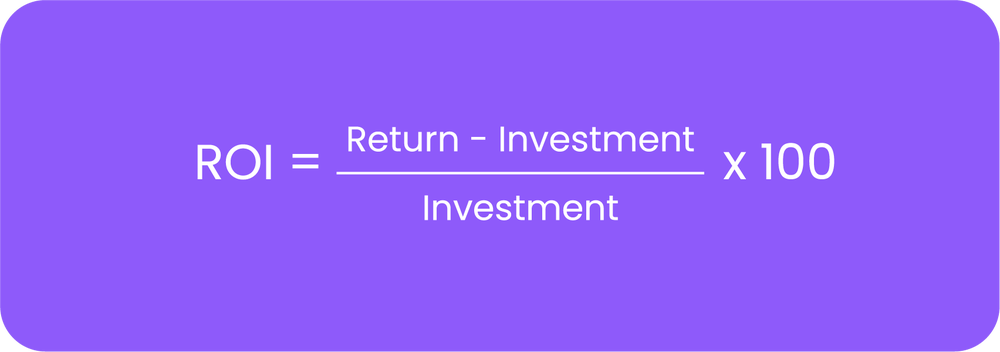More and more companies are investing on Employee Recognition as they acknowledge all the benefits for the business. Like every other investment you should measure its performance and whether it’s yielding the expected results or not.
If you’re designing a brand-new recognition program, keep in mind that when submitting a recognition program to management approval you should pitch it for what it truly is: an investment, not a cost. With an investment, a return comes along, so you should present the ROI of your recognition program.
It can be overwhelming to calculate the ROI of recognition but our Employee Recognition ROI Calculator makes it easier.

Free Resource: Employee Recognition ROI Calculator
What is the ROI of Recognition and how to calculate it?
The ROI of Recognition is the value that Recognition brings to your company. This metric will help you assess the return on your current Employee Recognition Program or estimate the return on an employee recognition program and build your business case for it.

“There is only one way to eat an elephant: a bite at a time”.
First thing we need to do to calculate the ROI of Employee Recognition is to identify the Return on Recognition, which are all the savings and gains you get from deploying an Employee Recognition Program. So, let’s start there.
An effective recognition program will:
- Lower Employee Turnover up to 31%
- Lower Employee Absenteeism up to 41%
- Increase productivity up to 21%
If recognition lowers turnover and absenteeism rates and it increases engagement, then this will generate real savings that will be the monetary return of investing on Employee Recognition.
Recognition savings = Turnover savings + Absenteeism Savings + Productivity Gains
Employee turnover and absenteeism cost companies a lot of money and there are still a lot of companies that had never quantified these costs. A survey by the Conference Board of Canada shows that only 40% of employers track absenteeism rates.
Turnover

This means that putting in place a recognition program you could save this much:
Turnover Savings = 31% x Turnover Cost
So now let’s dig into the Turnover Cost and what not to forget.
What is the real cost of turnover?
Turnover Cost can vary a lot depending on the job role and salary. Voluntary turnover can cost a company 1.5 to 2x the employee’s annual salary. The cost of losing an employee is too high not to keep an eye on it. Becoming aware of your cost of turnover will definitely give meaning to your turnover rate. Here’s all you should consider:
Recruiting Costs include expenses with:
- Advertising
- Resume Screening
- Interviewing
- Background Check
- Hiring
- Consultant or Recruiting Company’s Success Fee
Onboarding Costs include:
- Employee Welcome Pack
- Orientation
- Training
After deploying your recognition program, you will have enough data to calculate your ROI. Until then you can use benchmark figures:
- It's estimated that losing an employee can cost a company 1.5-2 times the employee's salary
The Hidden Costs of Turnover – Intangible expenses
People often say: “Everyone is replaceable”. Hmm… Sure, but at what cost? Aren’t there people at work would you say it would be a huge loss if they left?
It’s estimated that two thirds of all turnover costs are intangible, including productivity and knowledge losses. Don’t miss out on these hidden costs of turnover and attrition:
- Loss of knowledge: Vital knowledge about the organization, workflows and processes.
- Loss of productivity: A person takes time to be productive and fully autonomous. It can take up to 2 years to match the productivity of the employee who left.
- Customer service and errors: New employees take longer to solve problems and their error rate is higher.
- Drop in Sales: In some businesses you can lose valuable work-relationships established by the former employee. For example, a sales / account manager who had earned trust and established great relationships with his clients.
- Team Workloads: The workload that falls into the team members that need to compensate for this exit has a negative impact on the team.
- It may cause other employees to quit too: It may have an impact on the work dynamic. To address this impact, you should map out your employee influences to properly isolate and understand the impact of someone leaving. Have you ever experienced a case where a very influential manager leaves the company and shortly after others follow?
- Lowers Employee morale: The workplace is our second home, so we naturally build strong friendships in the workplace. When someone close leaves the company it affects us. This can affect one’s motivation and happiness at work. How many people met his / her best friend at work?
Creating a culture of recognition can save a 10,000-employee company up to $16.1 million in turnover costs annually.
Absenteeism

This means that putting in place a recognition program could save you this much:
Absenteeism Savings = 41% x Absenteeism Cost
So now let’s dig into the Absenteeism Cost.
The cost of Absenteeism
Absenteeism is missing work without notice due to sickness or other personal reasons. Frequent skips are a symptom of a disengaged employee. According to Inc. magazine, highly engaged employees take 37% fewer sick days.
Absenteeism Cost = Absenteeism Rate x Average Annual Salary
Benchmarks:
- The average workplace absenteeism rate in the US is 3.2% (2022)
- Absenteeism rate European Union - 27 countries (2020) 10%
- Absenteeism costs roughly $3,600 per year for each hourly worker and $2,660 each year for salaried employees.
Absenteeism Costs should include expenses with:
- Employee Salary during those absences
- The cost of replacing an employee if needed, doubling the costs.
- Administrative costs
Hidden Costs of Absenteeism include:
- Team Workload: whether because the team has to accommodate the work or because they begin to develop feelings of injustice.

Productivity Gains
Recognition not only boosts individual employee engagement, but it also has been found to increase productivity, according to Gallup.
Employee engagement yields "a 21% increase in productivity"
Productivity Gains = Nr of Employees x Employee Revenue x % of Productivity Gain
Investment
We have got to that time of the year when you start planning your annual budget for next year, right? You may be starting a recognition program or restructuring your current one. You may also be now comparing recognition platforms and wondering how much you should put on your budget.
So, how much should you invest in a recognition program? If you already have an employee recognition program in place, should you spend more or cut back? Investing too little will compromise the success of your Employee Recognition program, so you should carefully consider the right amount.
What is the benchmark cost of an effective recognition program?
Let’s look at what other companies are doing, to make sure you don’t overspend or underspend.
Employee Recognition Budget Benchmarks:
- Below Average: Under 1% of total payroll
- Average: 1-3% of total payroll
- Above Average: 4-10% of total payroll

The average budget for employee recognition and rewards is 2% of payroll. Regardless of how much you choose to allocate to your Employee Recognition Program, just keep in mind to choose an engaging platform that will help you build a culture of gratitude and positive feedback. Also keep your rewards meaningful and wide enough to appeal to everyone and keep everyone engaged.
Be smart allocating your resources 💸
When considering setting up an Employee Recognition Program you must carefully think about adopting a platform to enhance the recognition, achieve higher engagement and get higher adoption rate. A recognition platform holds a lot of advantages versus a manual recognition program.
Here are 5 benefits of using a Recognition Platform:
- Instantaneously Recognition
- Time saving for the HR team:
- Simplifies the reward redeem process
- Some offer integration with your HRIS (human resources information system) – manages users for you saving you a lot of time and trouble.
- Tax tracking – Some countries may make you pay taxes for employee rewards.
- Better Employee Experience
- Drives Employee Engagement
- Healthy Competition (with real-time leaderboard and social feed)
Calculating the ROI of Employee Recognition: Example

In this example there are some conservative estimates on what would be the savings and gains and still there’s a Return of 4x on the investment (a ROI of 437.68%).
Use our Calculator and calculate your Employee Recognition ROI.
Free Resource: Employee Recognition ROI Calculator

